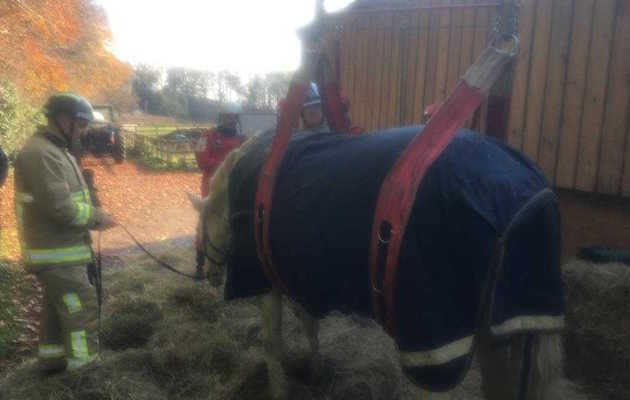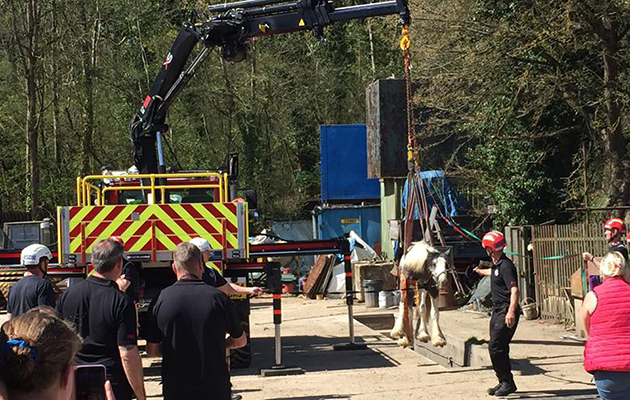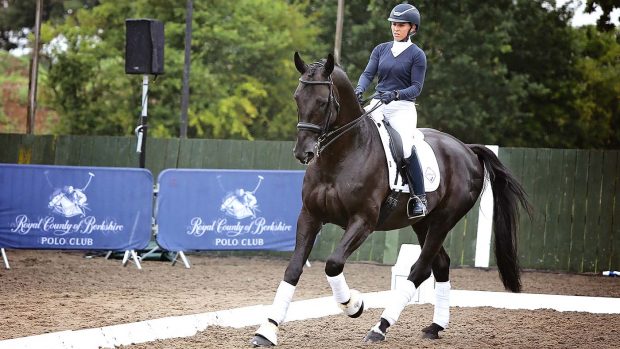An owner has praised the efforts of the fire and rescue service and her vets after her horse was successfully extracted from a disused car inspection pit.
Fourteen-year-old Connemara-thoroughbred cross Quigley was being walked across the boarded-over pit when he slipped and fell in what his owner Helen Keen described as a “freak” accident on Wednesday morning (21 November).
“I’ve walked him over it, ridden over it and driven over it hundreds of times,” said Helen, who has owned the gelding since he was five.
“He slipped and sat down on his haunches but instead of letting himself fall on to his side and then getting back up, he panicked and started scrabbling. As he did, he caught the edge of the board and flipped it up — there was enough of a gap to make one of his back legs go into the pit and by then he was at the point of no return and his whole back end dropped down.”
Helen had to move the board to allow Quigley to stand completely in the pit and said that although he panicked initially, he calmed down once he was in the hole. The pit was deep enough that the 15.1hh had to strain his head up to see out over the edge.
“It was full of stagnant water which was above his knees and I knew he’d cut himself while he was scrabbling, so I was worried about that,” said Helen, who immediately rang both the vet and fire and rescue service.
“Fortunately I had my phone on me so I could sit with him feeding him Polos to distract him. When I ran out I tried to walk off towards the barn to get more, but that started him stressing.”
Helen said that the “brilliant” animal rescue team from Royal Berkshire Fire and Rescue Service (RBFRS) wason scene, at the yard in Goring Heath, West Berkshire, within 15-10 minutes; while vet Richard Gillatt, a partner at McGonnell and Gillatt, was not too far behind.
Quigley was given light sedation while the team initially tried to extract him from the hole by putting straw bales in front and behind him to see if he could get himself out but there was not enough room.
“It didn’t work and just stressed him more, so we knew we’d have to lift him out. The firemen were worried they wouldn’t be able to get the rig down as it’s such a twisty-turny track with hardly any clearance. He had to reverse all the way down and it was brilliant driving.
“If they couldn’t have got the rig to him we would have had to use a hand winch which is slower and more noisy.”
Vet Richard said that had the fire service needed to use a hand winch, the horse would have had to be anaesthetised but just heavy sedation was required to use the rig. He said he had to lean over the pit to reach the horse’s vein, but was able to do so with the assistance of firemen holding on to his legs.
“They fit special slings underneath the horse which attach over the top and then when we were ready to go, I gave the horse really heavy sedation. Luckily he’s a nice horse and was really sensible and slowly and gently we were able to lift him up and get him on the side,” he added.

“We got the boards back over the pit to stop him going back into it and managed to extend the beam of the lifting gear away and put him just touching toes on ground. We then supported him until he was awake enough to stand on his own two feet. I put a catheter in and ran a drip of IV fluids to rehydrate him for shock and gave him painkillers.
“After we got him out we took off his wet rugs and replaced them with warm rugs and bandages.”
Richard added that he had been on a course earlier in the year with the British Animal Rescue and Trauma Care Association, which had kept him up to date with the latest techniques.
“This type of incident isn’t something we see every say in the practice, maybe only once a year,” he said.
Richard returned to check on Quigley the next day, and Helen reported he is recovering well from his ordeal.
“He’s got a few scratches on his back legs and they’re a little bit swollen and a bit bruised and stiff but other than that he’s been very lucky,” she said.
“My biggest worry throughout was that when they sedated him he’d go down and drown and there would be no way get him out but Richard did a good job judging the sedation level.
“Not every fire service has an animal rescue team and we were very lucky that ours is based just down the road in Caversham — they were really good guys. The rig was fabulous and really quiet.”
A spokesman for RBFRS said the service was called at 8.37am to reports of a horse trapped at Goring Heath in Reading.
Continues below…

Runaway cob rescued from car inspection pit after police chase
Firefighters and a vet worked to free the pony

Watch how firefighters rescue horses from perilous situations [VIDEO]
Find out how fire rescue services go about rescuing horses from dangerous situations — whether it's a steep-banked ditch or slurry

Subscribe to Horse & Hound magazine today – and enjoy unlimited website access all year round
“The Animal Rescue Unit from Caversham Road Fire Station, the Heavy Rescue Unit from Dee Road Fire Station and two officers were sent to the scene,” the spokesman said.
“Upon arrival, crews found a 14-year-old gelding which had fallen into an inspection pit. Firefighters lifted the horse out of the inspection pit and were on scene for around four hours. Following the successful extrication of the horse, the gelding was placed into the care of a vet.”
For all the latest news analysis, competition reports, interviews, features and much more, don’t miss Horse & Hound magazine, on sale every Thursday.




